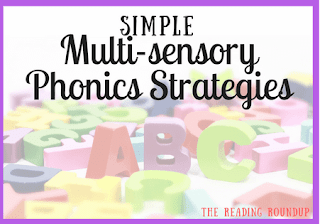Dyslexia has been a hot topic in education lately. In fact, Virginia is now requiring teachers to complete dyslexia training when applying for licensure in order to make sure educators know how to meet these students' needs. Hearing the word dyslexia can make some teachers nervous, but what they need to remember is that they are already implementing these strategies daily! Multisensory learning is beneficial for students with dyslexia to help activate multiple areas of the brain which helps these students make the necessary phonetic connections when working with words.
In order to reassure you that you DO already know how to help students with dyslexia, here are some simple multisensory phonics activities that are beneficial for these students that you're most likely already implementing!
**Post contains Amazon Affiliate links.
What can I use?
These are just a few suggestions. Be creative with other tools you can use!
- Shaving Cream
- Magnetic Letters
- Sidewalk Chalk
- Songs & Dances (link to an example of songs I use with my students)
- Gel Sensory Bags
- Play-Doh
- Sand / Sugar / Salt
- Air Writing
- Sandpaper Letters
- Pipe Cleaners / Wiki Sticks
What strategies should I try with these tools?
Here are a few suggested strategies you can implement with the tools mentioned above. The important thing is to make sure the students are verbalizing the sounds as they manipulate/write with the tools. This helps activate the different parts of the brain to strengthen the connections for the students.
- Practice writing letters
- Sight words writing practice
- Making word families
- Decoding unknown words
- Making Words
More about Making Words
Patricia Cunningham's Making Words is a structure that provides scaffolded support to students when working with words. Students are lead through steps to create new words by adding or deleting phonemes, manipulating letters to make words, and ultimately using all of the provided letters to make a mystery word. For example: Take 2 letters to make at. Add a letter to make cat. In the picture above, instead of having students manipulate letter tiles I had them become the letters. This added a kinesthetic approach which helped make the phonics skills more concrete for them.
is a structure that provides scaffolded support to students when working with words. Students are lead through steps to create new words by adding or deleting phonemes, manipulating letters to make words, and ultimately using all of the provided letters to make a mystery word. For example: Take 2 letters to make at. Add a letter to make cat. In the picture above, instead of having students manipulate letter tiles I had them become the letters. This added a kinesthetic approach which helped make the phonics skills more concrete for them.
Most likely you are already using many of these multisensory strategies or just needed a quick reminder about them. But what about your students' parents? I made a video series to explain and model various multisensory learning strategies. It is beneficial for parents and new teachers to view these strategies in action. Below is an example of one of these videos but a link is also provided to access the entire playlist.





Excellent tips and so easy to incorporate into the word study routine. Thanks Melissa!
ReplyDelete